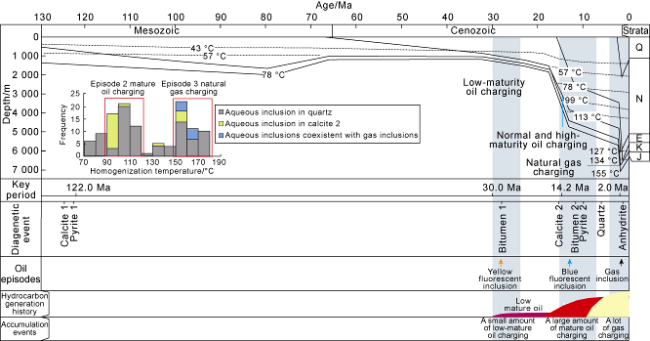Introduction
1. Geological setting
2. Samples and methods
3. Results
3.1. Petrography
Fig. 2. Petrographic characteristics of the authigenic minerals in the Qingshuihe Formation in the Gaoquan anticline. (a) Conglomerate dominated by moderately acidic mafic rock and tuffs, with pores almost filled with calcite; core photo; Well G101; 6554.00 m; (b) Conglomerate with intergranular pores and microcracks; Well G101; 6022.00 m; plane-polarized microphotograph; (c) Two phases of calcite under CL (large photo) and plane-polarized light (small photo); Well GQ5; 6051.40 m; (d) Bitumen 1 filling between calcite 1 and calcite 2, plane-polarized image; Well G101; 6018.60 m; (e) Subhedral pyrite 1 and microcrystalline pyrite; Well GHW001; 5829.30 m; SEM image; (f) Coexistence of bitumen 2 and pyrite 2; Well GQ5; 6068.00 m; (g) Coexistence of amorphous pyrite 2 and bitumen 2, with calcite coated by pyrite; Well GQ5; 6068.00 m; reflected light; (h) Coexistence of amorphous pyrite 2 and bitumen 2, the same field of view of (g) under plane-polarized light; WellGQ5; 6068.00 m; CL image of calcite on top left; (i) Anhydrite with microcrystalline quartz; Well GQ5; 6051.00 m; SEM image. |
3.2. Fluid inclusions
3.2.1. Fluid inclusion petrology
Fig. 3. Micro-characteristics of fluid inclusions. (a) Yellow fluorescent oil inclusion in calcite 1; Well GHW001; 829.30 m; polarized light and fluorescence image at bottom left; (b) Blue-white fluorescent oil inclusions in calcite 2; Well GHW001; 5829.30 m; fluorescence image; (c) Blue-white fluorescent oil inclusions in healed fractures in quartz; Well GHW001; 5842.10 m; ultraviolet light; (d) Gas inclusions in quartz; Well GQ5; 6125.56 m; plane-polarized microphotography; (e) Methane-bearing aqueous inclusions in calcite 2; Well GHW001; 5828.20 m; plane-polarized microphotography; (f) Aqueous inclusions in calcite 2; Well G101; 6018.60 m; plane-polarized microphotography. |
3.2.2. The spectral characteristics of fluid inclusions
Fig. 4. Spectra show fluid inclusion compositions. |
3.2.3. Homogenization temperature and salinity
Fig. 5. (a) Homogenization temperature histogram and (b) cross-plot of homogenization temperature and salinity of the Qingshuihe Formation in Gaoquan Structure. |
3.3. Compositions of calcite cements
Fig. 6. Rare earth element patterns of the calcite cements in the Qingshuihe Formation in the Gaoquan Structure in Junnan (normalized according to Reference [32], curves with different colors represent different points of samples). |
Fig. 7. (a) Carbon and oxygen and (b) Rb-Sr isotopic compositions of the calcite in the Qingshuihe Formation in Gaoquan Structure. |
3.4. LA-ICP-MS in-situ U-Pb dating
Fig. 8. LA-ICP-MS mapping and U-Pb dating results of calcite in the Qingshuihe Formation in Gaoquan Structure. (a) Cathodoluminescence image of two generations of calcite; Well G101; 6018.6 m; (b) characteristics of two generations of calcite; Well G101; 6018.6 m; larger image under plane-polarized light, and small one under cathodoluminescence; (c) U-Pb dating of calcite 1; Well G101; 6018.6 m; (d) 206Pb concentration map of calcite 2; Well G101; 6018.6 m; (e) 238U concentration map, the same field of view as d; (f) U-Pb dating of calcite 2; Well G101; 6018.6 m; (g) 206Pb concentration map of calcite 2; Well GQ5; 6018.6 m; (h) 238U concentration map, the same field of view as (g); (i) U-Pb dating of calcite 2; Well GQ5; 6018.6 m. |
4. Discussion
4.1. Semi-quantitative determination of diagenetic sequence and hydrocarbon charging events
4.2. Burial history reconstruction based on U-Pb dating
4.3. Significance of quantifying diagenetic and hydrocarbon charging sequences
Fig. 9. Comprehensive map including burial, diagenesis, pore evolution and hydrocarbon charging of the Qingshuihe Formation in Well GHW001 in Gaoquan Structure. |










